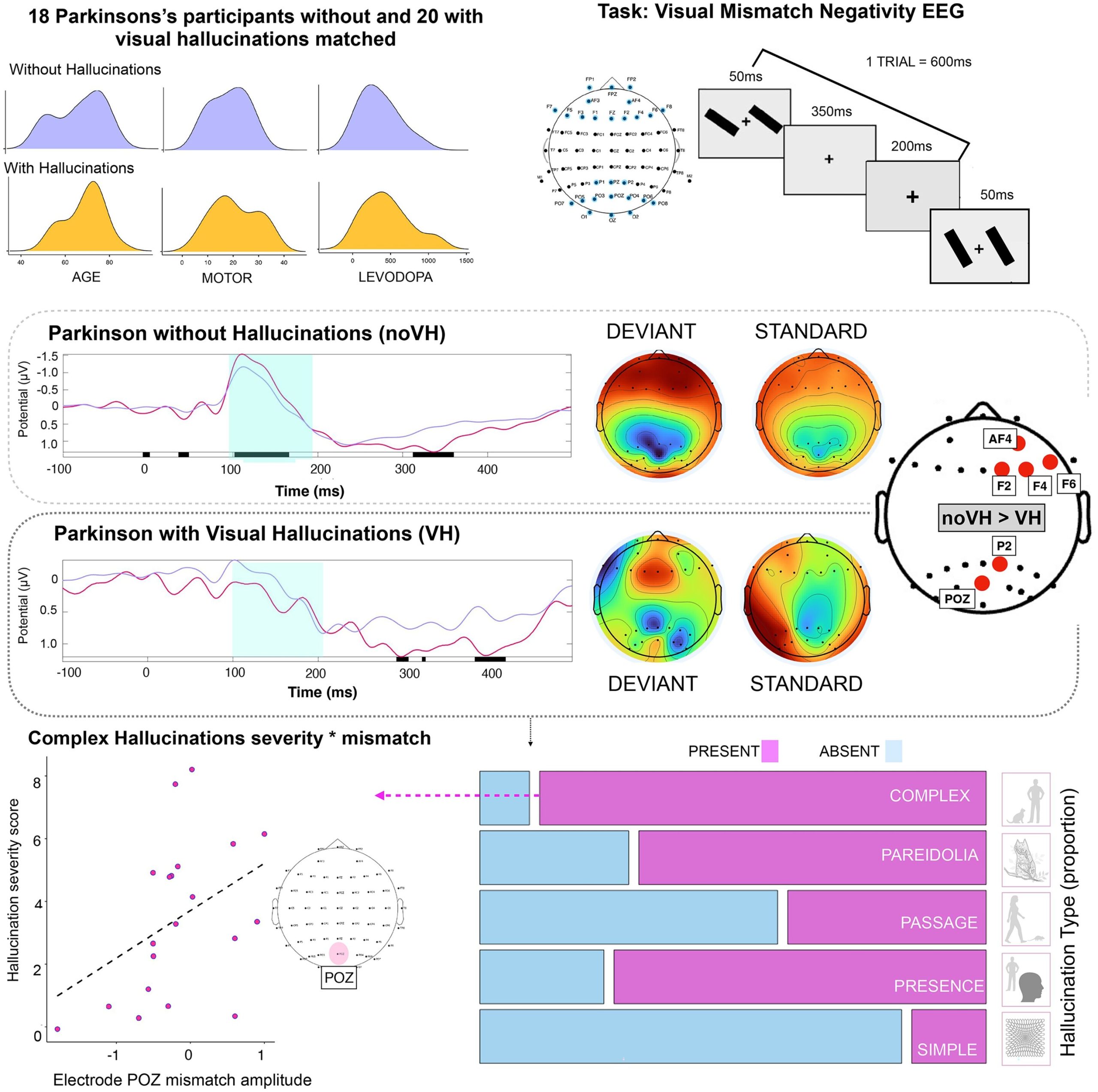
Reduced brain activity responding to unpredicted visual changes is a marker of psychosis in Parkinson’s disease and a potential therapeutic target. Researchers at the IoPPN used electroencephalography (EEG) to observe participant’s brain activity when presented with these visual cues. The aim is to determine whether visual mismatch negativity (vMMN) can be used to distinguish PD with visual hallucinations and PD without. The work is published in the journal Brain Communications.
Psychosis and visual hallucinations are one of the most common non-motor aspects of Parkinson’s disease (PD), affecting up to 40% of individuals with PD. Psychosis in PD commonly starts as minor hallucinations (for example the feeling of a presence in a room) which can develop into fully formed visual hallucinations, and delusions as the disease progresses. It greatly affects an individual’s quality of life.
The biology behind Parkinson’s disease psychosis (PDP) has been attributed to the use of dopaminergic drugs used to treat PD in the past. However, more recent research suggests that there are other mechanisms underlying PDP, as visual hallucinations have been reported by drug naïve people with Parkinson’s or receiving different types of PD medications.
The study observed 20 participants with PD with visual hallucinations and compared their EEG data, a measure of their brain electrical activity, with 18 people with PD, but without visual hallucinations. Participants were asked to focus their attention at a cross sign at the center of a screen and press a button when they noticed the cross changing size. They were asked to pay no attention to any images surrounding the cross, which are the unpredicted cues that will trigger vMMN.
Analysis of the EEG data shows that participants with PD with visual hallucinations show reduced vMMN in some areas of the brain. Additionally, the researchers observed a correlation between the severity of visual hallucination and amount of vMMN reduction.
“We were able to confirm that we can use visual mismatch negativity as a strong marker of psychosis in Parkinson’s disease. This is important because the experience of individuals living with Parkinson’s disease varies greatly, with both motor and non-motor symptoms.
“A deeper understanding of the brain mechanisms involved in hallucinations and psychosis can help individuals and their loved ones better understand the situations. In addition, this validation of the sensitivity of this task in discriminating between individuals with and without hallucinations, even when other clinical characteristics do not differ, is very promising: this task can be used as a marker for drug effects in investigations of new potential treatments,” says Miriam Vignando, Research Fellow at the Department of Neuroimaging and the first author of the study.
The research also looked at the role of the serotonergic pathway in Parkinson’s with visual hallucinations. Serotonin is a brain chemical involved in multiple brain processes. The pharmacological modulation of part of the serotonergic pathway observed reduced visual hallucinations induced by a psychedelic compound in healthy participants, and in five individuals with PD and hallucinations when compared to a placebo. This suggests that this pathway is a potential therapeutic target for this symptom.
“Parkinson’s disease psychosis is poorly understood. These psychosis symptoms do not have good treatments and they also indicate the patient may have a worse prognosis, with an increased risk of dementia.
“The EEG results tell us that Parkinson’s disease psychosis has some similarities with psychosis symptoms in other disorders, such as schizophrenia. We also pinpointed a key pathway, the serotonergic pathway, as a strong candidate for further drug development,” says Mitul Mehta, Professor of Neuroimaging & Psychopharmacology at King’s and the senior author of the study.
More information:
Miriam Vignando et al, Visual mismatch negativity in Parkinson’s psychosis and potential for testing treatment mechanisms, Brain Communications (2024). DOI: 10.1093/braincomms/fcae291
Citation:
Visual mismatch negativity identified as a mechanism of Parkinson’s disease psychosis (2024, October 1)
retrieved 5 October 2024
from https://medicalxpress.com/news/2024-10-visual-mismatch-negativity-mechanism-parkinson.html
This document is subject to copyright. Apart from any fair dealing for the purpose of private study or research, no
part may be reproduced without the written permission. The content is provided for information purposes only.

